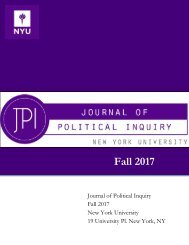JPI Spring 2018
Create successful ePaper yourself
Turn your PDF publications into a flip-book with our unique Google optimized e-Paper software.
a driving factor in PiS’ success because they are so successful despite the Polish National Election<br />
Study’s results, then increasing competition should, despite anti-NGO policies and anti-opposition<br />
efforts instigated by Kaczynski, engage young and progressive voters to re-introduce democracy into<br />
the Polish Parliament.<br />
The voter distribution across Trump supporters 27 leans heavily on those with less than a<br />
four-year degree as right-wing, populist, supporters also decreased with education which is contributed<br />
to education encouraging individuals is encouraged to seek alternative sources of information to help<br />
choose candidates with intentions that fit one’s needs rather than following populists because of their<br />
tagline campaign slogans such as “Make America Great Again” or “Dobra Zmiana” (‘Good Change’)<br />
which promise a bright future, without showing the costs. Alongside this apparent inverse relationship<br />
between college education and far-right wing candidate support with which we can say, the more<br />
education a voter receives, the less likely they were to support Trump.<br />
Income levels also affected decisions in the 2016 election. Voters with an income $50-<br />
99,999 28 per year were most likely to support Trump. This still shows that while many poor or<br />
uneducated supporters fell victim to Trump's populist campaign, median-income voters made up the<br />
bulk of support despite them being reasonably capable of understanding his biased campaign. This<br />
being said, they were still coerced through populism to make sacrifices for the upper classes 29 . This<br />
can be explained by the middle-income group’s exposure to education and relationship to their<br />
income. Many middle-income Republicans live in less urban areas and have elevated income despite<br />
their academic attainment due to technical skill related jobs such as welding where an average salary is<br />
around $64,000 per year despite education requirements being no more than a GED and possibly a<br />
two-year technical degree. This relationship to the middle class is an example of how information<br />
asymmetry affects election outcome. Because these voters, with minimal education, comprise a bulk<br />
of the state, they are a determinant of election outcome. Trump’s encouragement to speak out about<br />
their economic issues, and then counter it with social topic voting on the issues of immigration with<br />
comments about immigrants taking job opportunities away from this middle class, rallies support<br />
despite his actually contradictory and harmful intentions. The voters throw their support to the<br />
populist without having the knowledge whether they are doing the right thing and the populist, Trump<br />
in this case, is validated by the support of these voters as well as their party 30 .<br />
Kaczynski, and Prime Minister Morawiecki, invested in their election promise, a monthly<br />
child subsidy for the working poor and a subsidy for second and other subsequent children from<br />
middle and upper-class families which affect the same socio-economic groups as Republicans aimed<br />
with their tax plans. However, by engaging in this promise, the PiS is pressured to deliver while also<br />
beginning to be a contributor to the European Union budget but opposes the funds being politicized.<br />
So although the PiS is providing financial security for families, they still segregate themselves from the<br />
norm of total EU integration, harming their society as a whole. Investing in the health and welfare of<br />
one’s citizens is important and a sign of leadership, however both the Republicans and the PiS targeted<br />
the demographic they needed the most support from 31 resulting in more votes, but also by buying<br />
their support PiS and Republicans are putting themselves under high levels of scrutiny by those<br />
constituents.<br />
27<br />
“Where Donald Trump’s Support Really Comes From.” The Economist, The Economist Newspaper, 20 April 2016, Print<br />
28<br />
Rothwell, Jonathan T. and Diego-Rosell, Pablo, Explaining Nationalist Political Views: The Case of Donald Trump (November 2, 2016).<br />
29<br />
Rothwell, Jonathan T. and Diego-Rosell, Pablo, Explaining Nationalist Political Views: The Case of Donald Trump (November 2, 2016).<br />
30<br />
Akkerman et. al., pg. 1287.<br />
31<br />
Szczerbiak, Aleks., University of Sussex Politics Department, http://eprints.lse.ac.uk/70831/1/blogs.lse.ac.uk-<br />
How%20will%20Polands%20Law%20and%20Justice%20party%20govern.pdf.<br />
<strong>JPI</strong> Fall 2017, pg. 24
















